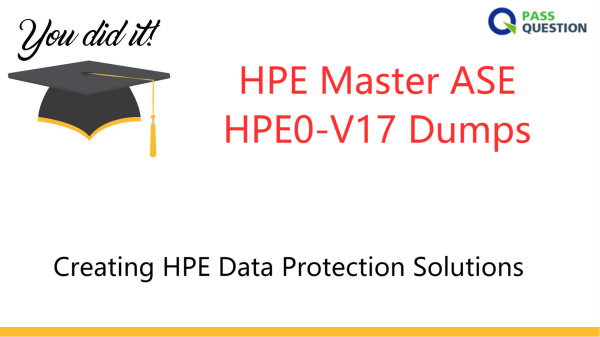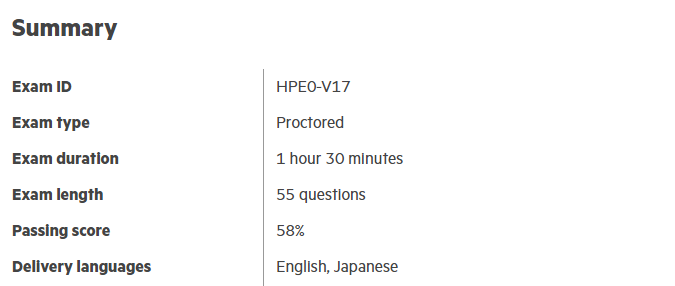HPE Master ASE HPE0-V17 Dumps For Creating HPE Data Protection Solutions
In order to help more candidates pass this HPE0-V17 Creating HPE Data Protection Solutions exam,PassQuestion new released the latest HPE Master ASE HPE0-V17 Dumps according to the real test objectives. All the HPE Master ASE HPE0-V17 Dumps are collected in high quality accuracy by certified experts and professionals in this field,and we will often update the HPE0-V17 Dumps to keep it latest. PassQuestion HPE Master ASE HPE0-V17 Dumps give you detailed and logical coverage of HPE0-V17 exam objectives, you can pass your HPE0-V17 exam with ease and confidence.

HPE0-V17 Exam Overview - Creating HPE Data Protection Solutions
This exam tests the candidate's ability to display competency in multiple data protection technologies, strategies, and deployment models in order to architect a solution and strategy that aligns with the customers' business drivers and mitigates potential risks.
This certification is targeted to solution architects who have experience designing and implementing complex data protection solutions and want to validate their skills to leverage HPE data protection solutions. Candidates typically define business needs, propose, and may deploy, the solution.

Exam Objectives
This exam validates that you can: Gather and evaluate a customer's service level requirements, identify potential risks, and assess existing infrastructure in order to design a data protection solution, including ongoing backup strategies, and communicate these to the customer.
9% Explain Data Protection and related Concepts:
- Determine the required data availability according to the customer's service level agreements
- Understand customer objectives, business drivers, and impacts Describe different data protection technologies
- Identify challenges associated with backup and recovery Identify risks and potential impacts in order to mitigate them
- Given a scenario, interpret pain points and their impact
- Demonstrate awareness of how compliance / legal requirements affect solution requirements
- Describe the data security requirements
- Describe the data protection cycle
- Describe the components of a data recovery plan
- Differentiate an application-consistent backup and a crash-consistent backup
6% Describe Data Retention Strategies:
- Describe data protection schemes
- Explain 3-2-1 as a data retention strategy
- Categorize data
- Differentiate between backup and archiving strategies
- Given a scenario, recommend a vaulting strategy
- Explain retention periods and the effects of data growth
9% Describe Data Protection Technologies:
- Describe how snapshots and replication play a role within a backup strategy (designed for fast restore on the same hardware)
- Differentiate between deduplication and compression
- Explain the role of removable media in a backup strategy Explain the role of cloud storage as a backup target
- Explain encryption and how keys are managed
- Contrast internal and external encryption (inflight or at rest) in terms of where the encryption is happening
- Differentiate between zero copy clones, smart clones, and snapshots
- Describe what VSS does during a backup
18% Describe Data Protector:
- Identify the components within a DP solution and describe their roles
- Describe the different DP licensing options
- Determine where the various components are deployed
- Identify the components within a Veeam solution and describe their roles
- Describe the different Veeam licensing options
- Determine where the various components are deployed
- Identify the components within a Commvault solution and describe their roles
- Describe the different Commvault licensing options
- Determine where the various components are deployed
- Display an awareness of key points regarding other relevant ISVs
18% Explain Data Protection Integrations and Tools:
- 3PAR / Nimble integrations - Identify the integrations that are used by the ISV
- Identify integration restrictions that exist as part of a given software solution
- Recognize that SimpliVity has its own internal backup mechanism
- Recognize that backup software may be used as part of the 3-2-1 guideline
- Describe the StoreOnce portfolio and NAS / VTL replication
- Describe the advantages of a Catalyst datastore
- Explain how Catalyst deduplication works
- Identify Catalyst compatibility with a given ISV
- Explain Catalyst Replication
- Explain the use and licensing of HPE Cloud Bank Storage
- Describe the StoreOnce integration with InfoSight
- Differentiate between StoreOnce and the competition
- Describe the StoreEver portfolio and options
- Distinguish between VTL and StoreEver, being able to recommend using both or just one
- Demonstrate an awareness of LTO backwards compatibility
- Explain RMC concepts
- Describe the integration of RMC with VMWare, SQL, Oracle, SAP, Exchange, and other critical applications
7% Describe Data Protection Tools and Tool Usage:
- Explain the purpose of NinjaProtected+
- Identify the components of HPE Assessment Foundry
- Explain the purpose of LTT (Library Tape Tools) troubleshooting, firmware updates
- Identify the purpose of Data Domain sizing tool (HPE DD Analyser)
- Identify the purpose of StoreEver Command View
- Identify the purpose of StoreEver TapeAssure
- Use the Storage Sizing Tool to generate a recommended solution (required for NP+ output)
- Use SPOCK and ISV compatibility lists to validate the solution
- Identify the purpose of HPE SAF Analyze
10% Perform Sizing and Planning - Gather information:
- Determine if the customer has an SLA and current risk analysis on which to base your potential solution
- Determine the amount and type of data required to be backed up, daily change rate, and expected annual growth
- Determine the required retention schedule
- Identify customers' current and/or planned backup strategies, operations, backup window, and RPO, RTO
- Determine if the customer has remote sites available for replication or backup
15% Design and Size the Solution:
- Select the appropriate backup software that meets the customer needs
- Determine the appropriate backup target
- Determine appropriate internal and external encryption (inflight or at rest) according to the customer's security policy if applicable
- Determine what servers are available (or need to be added) to house the various ISV components
- After design, determine if there are bottlenecks within the customer's existing infrastructure that will affect backup and/or restore and propose appropriate changes
- Attach the appropriate services
8% Validate and Propose the Solution:
- Given a customer scenario assess the policy and whether it fulfills the expected recovery times
- Verify compatibility with the customer's environment and the components used in the solution
- Given a scenario recognize and assess Customer needs, propose a solution and explain how they align to business drivers
View Online Creating HPE Data Protection Solutions HPE0-V17 Free Questions
1.is this a Commvauit feature that enables integration with HPE storage?
Solution: intelliSnap catalogs snapshot data to simplify the recovery of individual files.
A. Yes
B. No
Answer: A
2.You are working with your customer on the advantages and disadvantages of various data protection schemes. They currently have a storage solution with 2 HPE 3PAR arrays with Peer Persistence. This is used to make backups to an HPE StoreOnce VTL backup target using Commvauft.
Will this recommendation enhance the data protection plan?
Solution: Use the Grandfather-Father-Son (GFS) rotation scheme
A. Yes
B. No
Answer: A
3.A customer wants advice on their current data protection solution. Due to compliance regulation changes, the company requires lower RTO and RPO objectives for their Service Level Agreement (SLA) is this a correct statement regarding how HPE solutions can help to comply with this tighter SLA?
Solution: HPE disk-based backup solutions like HPE StoreOnce have Catalyst functionality, which enables Integration with HPE storage arrays like HPE Nimble and Primera.
Thus, you can send snapshots from the storage arrays directly to the backup target, with fast direct recovery through RMC
A. Yes
B. No
Answer: A
4.Is this a correct statement about the HPE StoreEver Tape Library Management software?
Solution: Tape Assure Advanced verifies system health and runs the tests that trigger an alert If there Is a problem with a tape drive or cartridge.
A. Yes
B. No
Answer: A
5.A customer has deployed a hyperconverged environment based on HPE Simplivity at a number of their sites.
Before migrating workloads to the environment, you ask them about the backup policies In an HPE simpliVity solution to protect the actual datais this a design consideration that you should mention to your customer?
Solution: The preference of COW (Copy-On-Write) or ROW (Redirect-On-Write) -based snapshots
A. Yes
B. No
Answer: A
- TOP 50 Exam Questions
-
Exam
All copyrights reserved 2025 PassQuestion NETWORK CO.,LIMITED. All Rights Reserved.

